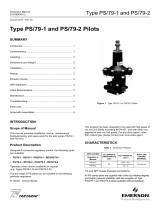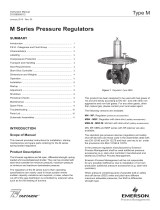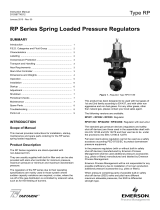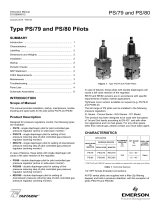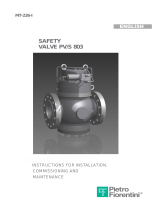Page is loading ...

BM7 Series
Instruction Manual
D103665X012
October 2014 - Rev. 00
TM
SUMMARY
Introduction ........................................................................ 1
PED Categories and Fluid Group ...................................... 2
Characteristics ................................................................... 2
Labelling ............................................................................ 2
Overpressure Protection .................................................... 3
Transport and Handling ..................................................... 3
Atex Requirements ............................................................ 3
Slam-Shut Controller ......................................................... 3
Dimensions and Weights ................................................... 4
Installation ......................................................................... 4
Startup ............................................................................... 5
OS/66 Slam-Shut Controller Adjustment ........................... 5
Shutdown ........................................................................... 5
Maintenance ...................................................................... 6
Spare Parts ........................................................................ 6
Troubleshooting ................................................................. 6
Parts List ............................................................................ 7
INTRODUCTION
Scope of Manual
This manual provides instructions for installation, startup,
maintenance and spare parts ordering for the BM7 Series
slam-shut valves.
Product Description
The BM7 Series slam-shut valves are automatic isolating
elements suitable for installation as safety devices in
regulating stations.
The slam-shut valves in the BM7 series are used in ltered
natural gas reduction stations.
This product has been designed to be used with fuel gases
of 1
st
and 2
nd
family according to EN 437, and with other non
aggressive and non fuel gases. For any other gases, other
than natural gas, please contact your local sales agent.
The slam-shut valves used in the assemblies dealt with
into EN 12186 and EN 12279 are considered standard gas
pressure devices.
In the safety slam-shut valves manufactured by Emerson
Process shall be used additional pressure accessories (e.g.
controller or lters) manufactured and labeled by Emerson
Process.
Emerson Process will be not responsible for any possible
inefciency due to installation of not own production
additional pressure accessories.
When pressure containing parts of the product have different
maximum allowable pressures (PS), the slam-shut valve is
differential strength type.
BM7 Series Slam-Shut Valve
Figure 1. BM7 Series Slam-Shut Valve

BM7 Series
2
PED CATEGORIES AND FLUID GROUP
According to EN 14382, only in Class A conguration (when
both over and under pressure protections are set up), this
slam-shut valve can be classied like a safety accessory
according to PED.
The minimum PS between SSD valve and controller shall be
the PS of the safety accessory to comply the provisions of
EN 14382 about integral strength type.
This product in its Class A conguration is a safety
accessory for pressure equipment in the following Pressure
Equipment Directive 97/23/EC categories.
For values of PS over 6 bar the BM7 slam-shut is differential
strength.
Table 1. P.E.D. Category for BM7 Series Slam-Shut Valves
PRODUCT SIZE CATEGORY FLUID GROUP
DN 1 1/2” - 2” and DN 40-50 IV 1
Built-in pressure accessories (OS/66 controller) conform
to Pressure Equipment Directive (PED) 97/23/EC Article
3 section 3 and were designed and manufactured in
accordance with sound engineering practice (SEP).
Per Article 3 section 3, these “SEP” products must not bear
the CE marking.
CHARACTERISTICS
Body Sizes and End Connection Styles
DN 1 1/2” - 2” GAS
DN 40 - 50 PN 16
DN 50 ANSI 150 (on request)
!
WARNING
Maximum Operating Inlet Pressure
(1)
p
u,max
= 14 bar
Version with OS/66 controller
Underpressure Set Range
0.007 to 0.45 bar
Overpressure Set Range
0.022 to 0.6 bar
Version with OS/66-AP controller
Underpressure Set Range
0.1 to 2.5 bar
Overpressure Set Range
0.2 to 5 bar
Minimum/Maximum Allowable Temperature (TS)
(1)
See label.
1. The pressure/temperature limits indicated in this instruction manual or any
applicable standard or code limitation should not be exceeded.
Functional Features
Accuracy Class AG : ± 1%
Response Time t
a
: ≤ 1 second
Temperature
Standard Version: Working -10° to 60°C
Low Temperature Version: Working -20° to 60°C
Materials
Threaded body: Spheroidal cast iron
Flanged body: Spheroidal cast iron or steel
Covers: Aluminium
Seat: Bras
Diaphragm: Fabric Nitrile (NBR) rubber
LABELLING
xxxx
body
Notified
Note 1
Note 2
Note 4Note 5
Note 5
Note 3
BOLOGNA ITALY
APPARECCHIO TIPO / DEVICE TYPE
DN2
DN1
bar
bar
bar
bar
PS
bar x PS barPSD PT=Bar
pdo
bar
DN sede
DN seat
Wds
Wdso
Wdsu
FAIL CLOSE
FAIL OPEN
TARTARINI
MATRICOLA / ANNO
SERIAL Nr. / YEAR
REAZIONE
FAIL SAFE MODE
NORME ARMONIZ.
HARMONIZED STD.
CLASSE DI PERDITA
LEAKAGE CLASS
CLASSE FUNZIONALE
FUNCTIONAL CLASS
FLUIDO GRUPPO
FLUID GROUP
EN
TIPO
TYPE
Cg
TS °C
pmax
/
1
1.5
TM
Figure 2. Label for BM7 Series Slam-Shut Valves
Note 1: See “Characteristics”
Note 2: Year of manufacture
Note 3: Class A or Class B
Only valves with overpressure and underpressure
settings can be classied in Class A.
Note 4: Class 1: -10°/60°C
Class 2: -20°/60°C
Note 5: PS: 14 bar
PSD: 6 bar
(differential strength congurations)

Series BM7
3
OVERPRESSURE PROTECTION
The recommended maximum allowable pressures are
stamped on the slam-shut valve label.
Upstream overpressure protection shall be provided if the
inlet pressure is greater than the maximum operating inlet
pressure (p
u,max
) and than the maximum allowable pressure
(PS, PSD).
Downstream side pressure after slam-shut valve’s
intervention shall stay within the actual maximum operating
set-up range to avoid anomalous back pressures that can
damage the slam-shut controller.
Downstream overpressure protection shall be also provided
if the slam-shut valve outlet pressure can be greater than the
PS of the slam-shut controller (differential strength type).
Slam-shut valve operation below the maximum pressure
limitations does not preclude the possibility of damage from
external sources or debris in the line.
The slam-shut valve should be inspected for damage after
any intervention
TRANSPORT AND HANDLING
Established transport and handling procedures shall be
followed to avoid any damage on the pressure containing
parts by shocks or anomalous stresses.
Built-up sensing lines and slam-shut controller shall to be
protected by shocks or anomalous stresses
ATEX REQUIREMENTS
!
WARNING
If the provisions of EN 12186 & EN 12279,
national regulations, if any, and specic
manufacturer recommendations are not
put into practice before installation and
if purge by inert gas is not carried out
before equipment’s start-up and shut-down
operations, a potential external and internal
explosive atmosphere can be present in
equipment & gas pressure regulating/
measuring stations/installations.
If a presence of foreign material in the pipelines is foreseen
and purge by inert gas is not carried out, the following
procedure is recommended to avoid any possible external
ignition source inside the equipment due to mechanical
generated sparks:
• drainage to safe area via drain lines of foreign materials, if
any, by inow of fuel gas with low velocity in the pipe-work
(5m/sec)
In any case,
• provisions of Directive 1999/92/EC and 89/655/EC shall
be enforced by gas pressure regulating/measuring station/
installation’s end user
• with a view to preventing and providing protection against
explosions, technical and/or organizational measures
appropriate to the nature of the operation shall be taken
(e.g. : lling/exhausting of fuel gas of internal volume
of the isolated part/entire installation with vent lines
to safe area - 7.5.2 of EN 12186 & 7.4 of EN 12279 ;
monitoring of settings with further exhaust of fuel gas to
safe area ; connection of isolated part/entire installation to
downstream pipeline; ….)
• provision in 9.3 of EN 12186 & 12279 shall be enforced by
pressure regulating/measuring station/installation’s end user
• external tightness test shall be carried out after each
reassembly at installation site using testing pressure in
accordance with national rules
• periodical check/maintenance for surveillance shall be
carried out complying with national regulations, if any, and
specic manufacturer recommendations.
SLAM-SHUT CONTROLLER
The following controllers are used with B/240 series
regulator with built-in slam-shut:
• OS/66 Series spring loaded controllers
Figure 3. OS/66 Slam-Shut Controller
Table 2. OS/66 Characteristics
MODEL
BODY
RESISTANCE
bar
OVERPRESSURE
SET RANGE
W
do
bar
UNDERPRESSURE
SET RANGE
W
du
bar
Min. Max. Min. Max.
OS/66 6 0.022 0.6 0.007 0.45
OS/66-AP 6 0.2 5 0.1 2.5
Materials
Body: Aluminium
Cover: Steel
Diaphragm: NBR rubber
For further informations please
see the Instruction Manual
0048EN-OS66-IM.

BM7 Series
4
TYPE A B C I Version Weight
BM7/ 1 1/2” 165 57 90 130 2 3
BM7/40-FS 165 57 90 184 3 7
BM7/2” 190 85 120 160 2 5
BM7/50-F 195 90 125 190 1 13
CB CB
Ø 125
A
Version 1 Version 2
Version 3
Ø 125
A
I
184
I
160
160
Figure 4. Type BM7 Series Dimensions
Table 3. Type BM7 Series Dimensions (mm) and weights (kg)
DIMENSIONS AND WEIGHTS
INSTALLATION
• Ensure that the data found on the slam-shut valve label
are compatible with usage requirements.
• Make sure that slam-shut controller is installed up-right.
• Ensure that the slam-shut valve is mounted in accordance
with the direction of ow indicated by the arrow.
• Make the connection of the pressure control pipe (B),
taking it off a straight section of the downstream pipe, if
possible far from narrow sections, curves, or branches, to
avoid variations in the release values of slam-shut device
caused by turbulence.
!
WARNING
Only qualied personnel should install or
service a slam-shut valve. Slam-shut valve
should be installed, operated, and main-
tained in accordance with international and
applicable codes and regulations.
If the slam-shut valve vents uid or a leak
develops in the system, it indicates that ser-
vicing is required.

Series BM7
5
Failure to take the slam-shut valve out of
service immediately may create a hazardous
condition.
Personal injury, equipment damage, or
leakage due to escaping uid or bursting
of pressure-containing parts may result if
this slam-shut valve is overpressured or is
installed where service conditions could
exceed the limits given in the “Characteris-
tics” section, or where conditions exceed
any ratings of the adjacent piping or piping
connections.
To avoid such injury or damage, provide
pressure-relieving or pressure-limiting de-
vices (as required by the appropriate code,
regulation, or standard) to prevent service
conditions from exceeding limits.
Additionally, physical damage to the slam-shut
valve could result in personal injury and prop-
erty damage due to escaping uid.
To avoid
such injury and damage, install the slam-
shut valve in a safe location.
Before installation, check shall be done if
service conditions are consistent with use
limitations and if its slam-shut device set-up
is in accordance with service conditions of
protected equipment.
All means for venting have to be provided in
the assemblies where the pressure equip-
ment are installed (ENs 12186 & 12279).
All means for draining have to be provided in
the equipment installed before the slam-shut
valve (ENs 12186 & 12279).
Further the ENs 12186 & 12279, where this
product is used:
• Provide the cathodic protection and elec-
trical isolation to avoid any corrosion
• In accordance with clause 7.3/7.2 of afore-
said standards, the gas shall be cleaned by
proper lters/separators/scrubbers to avoid
any technical & reasonable hazard of erosion
or abrasion for pressure containing parts
Slam-shut valve shall be installed in
non-seismic area and hasn’t to undergo re
and thunderbolt action.
Clean out all pipelines before installation of
the slam-shut valve and check to be sure the
slam-shut valve has not been damaged or has
collected foreign material during shipping.
Use suitable line gaskets and approved pip-
ing and bolting practices.
Installation must to be done avoiding anoma-
lous stresses on the body and using suitable
joint means (bolts, anges, …) according
equipment dimensions and service conditions.
Install the slam-shut valve in any position
desired, unless otherwise specied, but be
sure ow through the body is in the direction
indicated by the arrow on the body.
User has to check and carry out any protection
suitable for assembly’s specic environment.
For outdoor installations, the slam-shut
valve should be located away from vehicular
trafc and positioned so that water, ice, and
other foreign materials cannot enter into the
pilot mechanism.
Avoid placing the slam-shut valve beneath
eaves or downspouts, and be sure it is above
the probable snow level.
STARTUP
The built-in slam-shut controller is factory set at approximately
the midpoint of the spring range or the pressure requested, so
an initial adjustment may be required to obtain desired results.
a. loose
ning cap (C) and then screwing it onto the stem, after
which pull cap outwards until a click is heard, indicating
that balls are duly engaged.
b.
Slightly and very slowly open inlet shut-off valve.
c.
Wait for outlet pressure to stabilize.
d.
Finally, slowly
open outlet valve fully.
OS/66 SLAM-SHUT CONTROLLER
ADJUSTMENT
To change the set-points (overpressure and/or
underpressure), remove the spring closing cap of the pilot
and turn the adjusting screws clockwise to increase outlet
pressure or counter-clockwise to decrease pressures.
Monitor the outlet pressure with a test gauge during the
adjustment.
Replace the closing cap to maintain the desired setting
SHUTDOWN
!
WARNING
To avoid personal injury resulting from sudden
release of pressure, isolate the slam-shut
valve from all pressure before attempting
disassembly and release trapped pressure
from the equipment and pressure line.
In
case of disassembly of main pressure
retaining parts for checks and maintenance
procedures, external and internal tightness
tests have to be done according to
applicable codes.

BM7 Series
6
Table 6. Troubleshooting for BM7 Series Slam-Shut Valve
SYMPTOMS CAUSE ACTIONS
Slam-shut device does not remain set
The actuator impulse intake (B) is not
connected properly
Check connections (A)
Downstream pressure coincides with the
maximum or minimum slam-shut settings
Check slam-shut settings
Slam-shut controller is not working properly Check slam-shut controller
Sleeve does not seal properly
Pad unit (key 12) is worn Replace pad unit
Dirt deposit on seat (key 1) Check seat
TROUBLESHOOTING
MAINTENANCE (SEE FIGURE 5)
!
WARNING
All maintenance procedures must be carried
out only by qualied personnel.
If necessary, contact our after sale support
representatives or our authorized dealers.
The valve and it’s pressure accessories are subject to
normal wear and must be inspected periodically and
replaced if necessary.
The frequency of inspection/checks and replacement
depends upon the severity of service conditions and
according to applicable National or Industry codes,
standards and regulations/recommendations.
In accordance with applicable National or Industry codes,
standards and regulations/recommendations, all hazards
covered by specic tests after nal assembling before
applying the CE marking, shall be covered also after
every subsequent reassembly at installation site, in order
to ensure that the equipment will be safe throughout its
intended life.
Before proceeding with any maintenance work, shutoff the
gas upstream and downstream from the valve, also ensure
that there is no gas under pressure inside the body by
loosening the upstream and downstream connections.
Upon completion, check for leaks using suds.
General Maintenance
a. Remove the OS/66 (key 26) by the suitable sprigs.
b. Unscrew plug (key 8), for BM//2”-F version remove it by
removing the screws (key 23).
c. Remove the screw (key 19), remove the clamp (key 18)
and remove the seat (key 1).
d. Check and replace if is necessary the O-ring (key 2, 5, 6,
10, 16) and the pad Unit (key 12).
For the OS/66 maintenance please
see the Instruction
Manual
0048EN-OS66-IM.
Reassembly
Lubricate all seals with MOLYKOTE 55 M or equivalent,
being very careful not to damage them when reassembling.
Reassemble the parts by reversing the above steps.
As you proceed, make sure that parts move freely and
without friction.
In addition:
a. Complete reassembly and make sure to tighten all screws
uniformly.
b. Upon completion of reassembling procedure, adjust slam
shut valve set-points and check valve relatching.
c. Reassemble the valve on the line and restore the
connections.
SPARE PARTS
Spare parts storage shall be done by proper procedures
according to national standard/rules to avoid over aging or
any damage (Ref.:ISO2230).

Series BM7
7
Section A-A
18
19
20
21
45612
11 915 1317 16 10 812
22
25
26
27 28 1423 24
7
AA
B
C
BM7/2” Version
38
BM7/1 1/2” and BM7/40-FS Version BM7/40-FS Version
12
12
3
8
29 30 31
PARTS LIST
Key Description
1 Seat
2* O-ring
3 Filter
4 Shaft
5* O-ring
6* O-ring
7 Spring carrier
8 Plug
9 Spring
10* O-ring
11 Pad holder
12* Pad unit
13 Elastic ring
14 Screw
15 Body
16* O-ring
17 Cap
18 Clamp
19 Screw
20 washer
21 Nut
22 Pipe tting
23 Screw
24 Washer
25 Label
26 Slam-shut controller OS/66
27 Plug
28* Gasket
29 Sliding ange
30 Hub
31 O-ring
Rubber parts marked with (*) are supplied in
the “spare parts kit”, recommended as stock.
To order the kit it is necessary to communicate to
us the type of the slam-shut valve or slam-shut
controller and its serial number.
Figure 5. BM7 Series Slam-Shut Valve

Serie BM7
The Emerson logo is a trademark and service mark of Emerson Electric Co. All other marks are the property of their prospective owners. Tartarini is a mark of O.M.T. Ofcina Meccanica Tartarini s.r.l.,
a business of Emerson Process Management.
The contents of this publication are presented for informational purposes only, and while every effort has been made to ensure their accuracy, they are not to be construed as warranties or guarantees,
express or implied, regarding the products or services described herein or their use or applicability. We reserve the right to modify or improve the designs or specications of such products at any
time without notice.
Emerson Process Management Regulator Technologies, Inc., does not assume responsibility for the selection, use or maintenance of any product. Responsibility for proper selection, use and
maintenance of any Emerson Process Management Regulator Technologies, Inc., product remains solely with the purchaser.
©Emerson Process Management Regulator Technologies, Inc., 2014; All Rights Reserved
Industrial Regulators
Emerson Process Management
Regulator Technologies, Inc.
USA - Headquarters
McKinney, Texas 75070, USA
Tel: +1 800 558 5853
Outside U.S. +1 972 548 3574
Asia-Pacic
Shanghai 201206, China
Tel: +86 21 2892 9000
Europe
Bologna 40013, Italy
Tel: +39 051 419 0611
Middle East and Africa
Dubai, United Arab Emirates
Tel: +971 4811 8100
For further information visit www.emersonprocess.com/regulators
Natural Gas Technologies
Emerson Process Management
Regulator Technologies, Inc.
USA - Headquarters
McKinney, Texas 75070, USA
Tel: +1 800 558 5853
Outside U.S. +1 972 548 3574
Asia-Pacic
Singapore 128461, Singapore
Tel: +65 6777 8337
Europe
O.M.T. Tartarini s.r.l. Via P. Fabbri 1,
I-40013 Castel Maggiore (Bologna), Italy
Tel: +39 051 419 0611
Francel SAS, 3 ave Victor Hugo,
CS 80125 - Chartres 28008, France
Tel: +33 2 37 33 47 00
Middle East and Africa
Dubai, United Arab Emirates
Tel: +971 4811 8100
TESCOM
Emerson Process Management
Tescom Corporation
USA - Headquarters
Elk River, Minnesota 55330-2445, USA
Tels: +1 763 241 3238
+1 800 447 1250
Asia-Pacic
Shangai 201206, China
Tel: +86 21 2892 9499
Europe
Selmsdorf 23923, Germany
Tel: +49 38823 31 287
O.M.T. Ofcina Meccanica Tartarini S.R.L., R.E.A 184221 BO Cod. Fisc. 00623720372 Part. IVA 00519501209 N° IVA CEE IT 00519501209,
Cap. Soc. 1.548 000 Euro i.v. R.I. 00623720372 - M BO 020330
Francel SAS, SIRET 552 068 637 00057 APE 2651B, N° TVA : FR84552068637, RCS Chartres B 552 068 637, SAS capital 534 400 Euro
/



